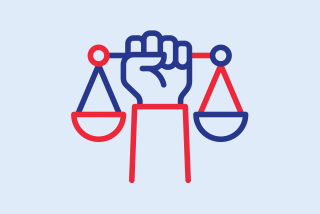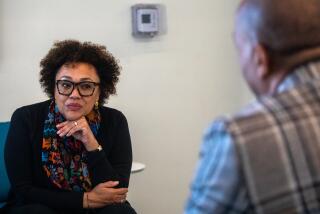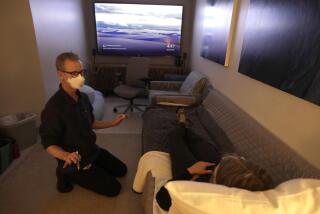Minor Commission Takes on Major Role as NEA Peacemaker : Arts grants: The panel may provide politicians with a report that has the look of bipartisan objectivity. Constitutional lawyers testify against content controls on federally funded artwork.
- Share via
WASHINGTON — An obscure commission set up by Congress in October and given six months to evaluate the National Endowment for the Arts and its grant-making procedures is emerging as a key force in resolving the controversy over the federal arts agency.
When the NEA’s renewal seemed possible by the end of July, the 12-member Independent Commission appeared destined to become an irrelevant footnote to the whole controversy.
But when attempts to reauthorize the NEA ground to a halt last week as a House floor vote on the matter was put off until September, the commission re-emerged as a means to provide valuable cover to politicians by delivering a report that is intended to have the appearance of bipartisan objectivity.
“Maybe not within the last week, but certainly within the last three weeks, the role of the commission has completely changed,” said Anne Murphy, executive director of the American Arts Alliance and an influential arts policy observer here.
The commission is chaired by John Brademas, a former Democratic congressman and now New York University president, and Leonard Garment, a Washington lawyer and influential Republican.
Delays in nominating and confirming the commission’s members--including one nominee proposed by President Bush but who reportedly failed an FBI background check--kept the commission from being sworn in and beginning its investigation until June 6. With a budget of $250,000, the commission has only until Sept. 30 to deliver its report.
Margaret Wyzomirski, the commission director, said Tuesday the panel intends to deliver its report on schedule--a place in time where the document and its recommendations could strongly influence the NEA’s 1991 appropriation bill in Congress and the pending reauthorization legislation.
Rosalind Wyman, a former Los Angeles city councilwoman and a member of the Independent Commission, said Tuesday that the panel hopes to start internal debate on its recommendations next week.
On Tuesday, the commission heard constitutional lawyers argue that last year’s congressional attempts to write restrictions on the content of federally supported artworks had failed and raised serious questions about the preservation of artistic freedom of expression in the process.
But the attorneys largely agreed that Congress can legally exert significant influence over the NEA’s artistic choices--for instance, by instructing the agency in legislation to pay more attention to visual arts and less to music.
However, Kathleen Sullivan, a Harvard Law School professor and First Amendment authority, said that discrimination in NEA legislation against any specific artistic viewpoint--which would be embodied in prohibitions on “homoerotic,” “blasphemous” or “offensive” art--would clearly run afoul of the Constitution, no matter how carefully they were written.
“The very worst kind of restriction is viewpoint discrimination,” Sullivan said. “There can be no hit lists of disfavored ideas in art.”
Michael McConnell, a University of Chicago Law School expert, suggested that a number of constitutionally acceptable reforms are possible at the NEA, including a provision under which panels of arts experts who make initial grant recommendations would offer NEA Chairman John E. Frohnmayer and the National Council on the Arts more choices than grants available. That would permit the council, which advises Frohnmayer on arts policy, and the chairman to make the final cut--by standards different from strict tenets of artistic excellence.
Appearances by Sullivan and five other attorneys Tuesday also saw evidence of sharp ideological divisions on the Independent Commission.
After the first panel of three lawyers had been seated for more than 90 minutes, commission member David Connor, a Peoria, Ill., businessman and museum trustee, angrily told the lawyers their presentations were irrelevant: “The issue is what kind of restrictions (on the NEA) the political body can live with, not what lawyers can live with.”
The remark prompted a rebuke by Garment, who apologized for Connor’s outburst, to applause by most of the other commission members. The commission has also heard persistently skeptical conservative questioning by John Agresto, president of St. John’s College in Santa Fe, N.M.
Presentations by two panels of constitutional scholars came a day after Frohnmayer spent most of a morning with the Independent Commission. Also on Monday, Frohnmayer’s predecessor at the endowment, Frank Hodsoll, met with the commission in private for more than an hour--the first time Hodsoll, now an official at the Office of Management and Budget, has taken a direct role in the public NEA debate.
Frohnmayer suggested that different “standards” may govern what art is acceptable for public and private funding. As an example, he cited a photograph of Holocaust victims, which, he contended, “might be inappropriate for display in the entrance of a museum where all would have to confront it.”
“The NEA does, and in my view, should consider standards other than substantial artistic and cultural significance and the maintenance and encouragement of professional excellence,” Frohnmayer said.
More to Read
The biggest entertainment stories
Get our big stories about Hollywood, film, television, music, arts, culture and more right in your inbox as soon as they publish.
You may occasionally receive promotional content from the Los Angeles Times.










